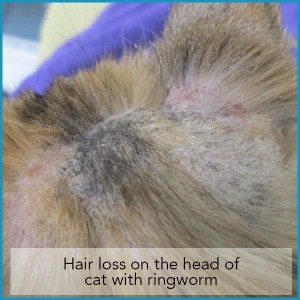Last Updated: 4 months ago
Cats are beloved pets, but they can be prone to certain health issues. One of the most common is ringworm, a fungal infection that can cause skin irritation and hair loss. How to treat ringworms in cats is a multi-step process that involves both topical and oral medications.
Topical treatments are applied directly to the skin to kill fungal spores, which helps prevent environmental contamination and the spreading of infection to other animals. Oral medications are considered the most effective treatment against ringworm in cats as they target the fungus itself to stop reproduction and spread.
Treatment typically lasts for 4-6 weeks or longer depending on your cat’s diagnosis, with two consecutive negative ringworm cultures needed before therapy can be stopped. Side effects from antifungal medication are possible but should not be a deterrent from seeking medical attention if you suspect your cat has contracted ringworm.
In addition to learning how to treat ringworms in cats, it is important to clean their environment thoroughly to lower the risk of reinfection. This includes:
- Washing bedding regularly.
- Vacuuming carpets often.
- Cleaning litter boxes daily.
- Wiping down hard surfaces with disinfectant cleaner weekly.
- Disposing of any contaminated items that cannot be washed or vacuumed properly such as stuffed toys or furniture upholstery covers.
- Applying bleach diluted 1:10 when mopping floors, tiles, and walls.
- Replacing air filters monthly (or more frequently if necessary).
- Ensuring adequate ventilation throughout the house by opening windows regularly.
If you suspect your cat has ringworm, it’s important to take action quickly and treat it properly. If you want to know more about how to treat ringworms in cats, read on for more information!
Table of Contents
What Is Ringworm?
Ringworm is a common fungal infection that can affect cats, humans, and other animals. It’s caused by several types of fungi called dermatophytes which feed on the keratin in skin, hair, and nails.
Although it’s not dangerous to cats or people, ringworm can be highly contagious and cause uncomfortable symptoms like redness, itching, scaling skin patches, and bald spots.
If your cat has been exposed to another animal with ringworm or if you notice any of the above symptoms on its fur or skin, here are a few things you can do.
1. Visit Your Veterinarian
The first step is to make an appointment with your vet for an accurate diagnosis. They will likely do a physical exam as well as take skin samples for laboratory analysis. This will help them determine whether your cat has ringworm or another condition that looks similar but requires different treatment options.
2. Follow The Treatment Plan
Topical antifungal medications applied directly to the affected area are the most effective way to treat mild cases. More severe cases may require oral medication along with environmental cleaning measures such as washing bedding in hot water (at least 130°F) and vacuuming carpets with HEPA filters.
3. Isolate Infected Cat
To prevent the spread of the fungus, be sure to isolate the infected cat away from other pets in the house until all signs of infection have cleared completely.
Make sure each pet has its own food bowl, water bowl, litter box, and toys to eliminate any chance of cross-contamination.
4. Monitor Progress
Keep an eye on new signs of infection. If symptoms reappear, contact your vet right away so they can adjust treatment accordingly.
Symptoms of Ringworm
The most obvious symptom of ringworm in cats is patchy hair loss. This usually appears as circular bald spots on their fur, often accompanied by scaly skin underneath the affected area.
Other signs include itching, redness, inflammation, and crusting around the lesions.
Your cat may also show signs of discomfort or pain when touched in these areas.
If your cat displays any of these symptoms, it’s important to take them to the vet for diagnosis and treatment as soon as possible.
The vet will likely perform a physical examination along with some tests such as a fungal culture or skin scraping to confirm whether your pet has ringworm or not.

(Source)
How to Treat Ringworm
The most common treatments for ringworm in cats include topical antifungal creams or ointments, oral medications such as griseofulvin or terbinafine, and medicated shampoos or sprays.
Depending on the severity of the infection, your veterinarian may recommend one or more of these treatments.
Topical antifungal creams and ointments are applied directly to the affected area once daily until symptoms subside. These products contain active ingredients like miconazole nitrate which helps to kill off the fungus causing the infection while also providing relief from itching and inflammation associated with ringworm infections in cats.
Oral medications like griseofulvin and terbinafine are usually prescribed when topical treatments have been unsuccessful at treating the infection.
Medicated shampoos and sprays containing chlorhexidine gluconate can also be part of a treatment plan if your cat does not have sensitive skin.
No matter what type of treatment you choose for your cat’s ringworm infection, make sure you follow through with all instructions given by your vet including any special bathing instructions and dietary restrictions.
Additionally, make sure you keep up with regular checkups during the treatment period so that any new outbreaks can be treated quickly before they become too severe.
How to Prevent Future Outbreaks
After your cat has fully recovered, here are a few things you can do to prevent any future ringworm outbreaks.
- Keep your home clean especially around litter boxes since fungi thrive in warm moist environments.
- Bathe your cat regularly.
- Keep claws trimmed short so they don’t scratch themselves and allow entry points for fungi.
- Provide plenty of fresh water so cats don’t drink out of dirty puddles which could contain spores from infected animals.
- Avoid contact between infected pets and healthy ones.
Taking these precautions will go a long way toward helping keep your furry friend safe and healthy.
FAQs About How to Treat Ringworms in Cats
How can I treat cat ringworm at home?
- Quarantine your kittens if ringworm is suspected or diagnosed.
- Sanitize the infected space frequently.
- Give two medicated baths or dips per week.
- Clean lesions and apply a topical ointment daily.
- Give oral medication if prescribed by a vet.
Will cat ringworm go away by itself?
Ringworm infection will go away on its own but it can often take several months. During this time, your kitty can spread the ringworm to other animals and humans.
And, on top of that, it can be very itchy for your furry friend. Luckily, medication can speed up the healing process and relieve the itching.
How can you tell if a cat has ringworms?
The most common clinical signs of feline ringworm include:
- Circular areas of hair loss.
- Broken and stubbly hair.
- Scaling or crusty skin.
- Alterations in hair or skin color.
- Inflamed areas of skin.
- Excessive grooming and scratching.
- Infected claws or nail beds.
- Dandruff.
How contagious is ringworm from cat to human?
Ringworms are a type of fungal infection that is highly infectious. The fungus is passed on by direct contact with cats if you have a scratch, graze, cut or open wound.
Conclusion
Are you concerned about how to treat ringworms in cats? Don’t worry, CatVills is here to help! Our comprehensive guide will provide you with all the information you need to know about treating ringworms in cats.
From prevention tips to treatment options, we have it all covered. So don’t wait any longer – start learning how to keep your cat healthy and happy today.

Olfa knows how to get things done and has a keen business sense that others admire. She’s always on the go, coming up with new ideas! Her ability to anticipate the needs of her readers and deliver information that they want is what makes CatVills such a success. She loves cuddling her cat Picaciu. He is her inspiration.
